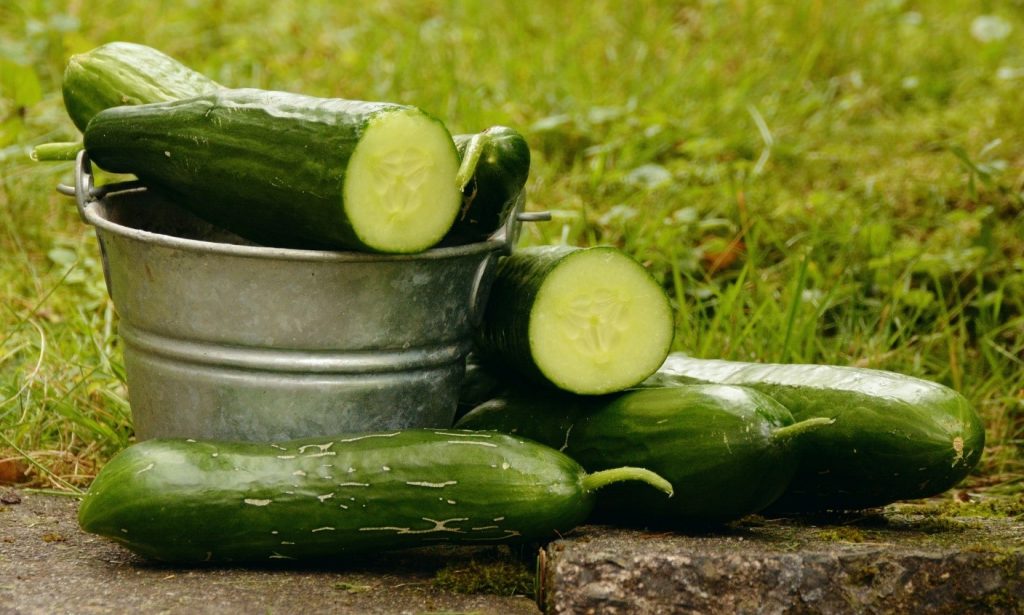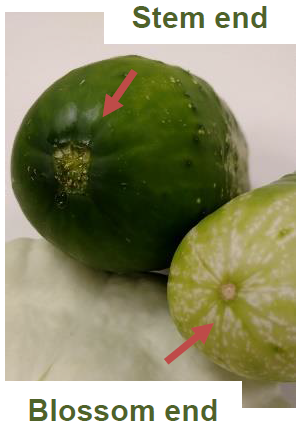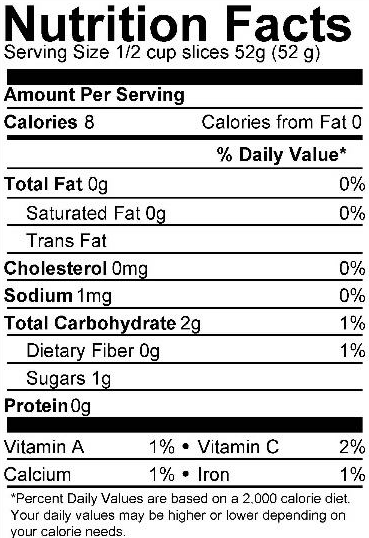Cucumbers (Cucumis sativus) belong to the Cucurbitaceae family, which also includes melons and summer and winter squash. Cucumbers have a firm outer rind, and range in color from yellow and orange to white and green. Commercial cucumbers are separated into two categories: slicing and pickling. Slicing cucumbers are usually 8-9 inches long with thick skins, making them less prone to damage after harvest and during transport. However, thinner skinned varieties know as English cucumbers are also in the slicing cucumber category. Pickling cucumbers typically have a warty, thin, light green colored skin with the fruit size ranging from 3-7 inches. Although they can be eaten fresh, they are typically used to make pickles.

Seasonality
Cucumbers are a warm-season vegetable, and need warm temperatures and frost-free weather to grow and mature. They produce fruit when night temperatures are above 50° F, and are suited for growing at elevations below 5,500 feet. To extend the growing season in Colorado, cucumbers can be started indoors, and then grown in greenhouses or transplanted outside after the last frost date. Colorado cucumbers are typically harvested mid-July through mid-October.
Food Safety
Cucumbers were associated with multi-state Salmonella outbreaks in 2013, 2014, and 2015. It is important to use safe food handling practices when preparing cucumbers. Bacteria on the outside of the cucumber can be transferred to the inside during peeling and preparation, so always wash the outside well under clean running water using a vegetable brush before peeling or slicing. Commercially-produced cucumbers are often coated with food grade wax which is not easily removed by washing.
Selection
Freshly harvested cucumbers should be firm with a bright, even color. Avoid cucumbers that have blemishes, softs spots, or discoloration.
Handling and Storage
Take care to store cucumbers separate from produce that generates ethylene, such as apples and tomatoes. Ethylene causes the cucumber to become discolored rapidly from the loss of chlorophyll. To maximize shelf-life, cucumbers should be stored at a cool temperature and high humidity, such as the crisper drawer in the refrigerator.
Consumption

Americans consume an average of 6.5 pounds of fresh cucumbers annually per person. Approximately 60% of cucumbers are consumed fresh and 40% are consumed as pickled products.
What does the phrase ‘cool as a cucumber’ mean?
Calm, untroubled by stress. The coolness of a cucumber is attributed to the inner temperature being up to 20°F cooler than the outside air temperature due to the high water content.
Pickles

When preserved as pickles, cucumbers are still low in calories and retain many of their nutrients, but their sodium content is increased due to added salt. Low-sodium commercial pickles are available and recipes for preserving cucumbers with reduced sodium can be found in CSU Extension’s Food Preservation without Sugar or Salt‘ fact sheet.
Kosher Dills (6 or 7 pints)
Recipe from ‘So Easy To Preserve’
- 30-36 pickling cucumbers, 3-4 inches long
- 3 cups vinegar, 5% acidity
- 3 cups water
- 6 T canning salt
- Fresh or dried dill
- Garlic
- Mustard Seed
Wash the cucumbers and cut off blossom ends. Combine the vinegar, water and salt to make brine. Bring to a boil. Place a generous layer of dill, ½ to 1 clove of garlic, and ½ teaspoon of mustard seed in bottom of each clean, hot pint jar. Pack cucumbers into jars and ladle hot brine over them, leaving ½ inch headspace. Remove air bubbles. Wipe jar rims. Adjust lids. For altitudes of 1000-6000 feet, process pints for 15 minutes (20 minutes above 6000 feet) in a boiling water bath.
Refer to CSU Extension’s ‘Making Pickles‘ fact sheet for detailed information on making pickles and directions for water bath canning.

Why does the blossom end need to be removed when making pickles?
The blossom end (opposite the stem end) contains enzymes that can cause softening. Remove at least 1/16th inch from the blossom end of cucumbers when making pickles.
Nutrition and Health

Cucumbers are unique in being able to provide both crunch and coolness to salads and sandwiches, as well as displaying an alternative personality as pickles. Additionally, a half cup serving of unpeeled cucumbers contains just 8 calories because they are primarily water (90-95%)!
With their high water content, cucumbers are not as nutrient dense as many other vegetables, but they do provide small amounts of iron, manganese, and potassium as well as fiber, vitamins A and C. And one cup of cucumbers also provides 19% of the daily recommended amount of vitamin K.
Cucumbers also contain the phytochemicals cucurbitacins, lignans, and flavonoids, which may provide antioxidant and anti-inflammatory benefits.


